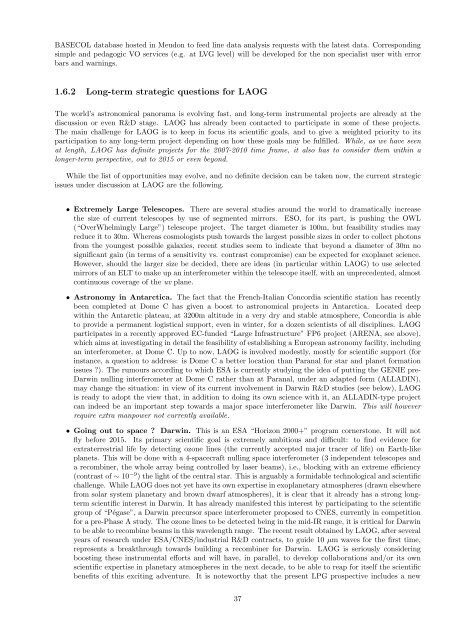Untitled - Laboratoire d'Astrophysique de l'Observatoire de Grenoble
Untitled - Laboratoire d'Astrophysique de l'Observatoire de Grenoble
Untitled - Laboratoire d'Astrophysique de l'Observatoire de Grenoble
You also want an ePaper? Increase the reach of your titles
YUMPU automatically turns print PDFs into web optimized ePapers that Google loves.
BASECOL database hosted in Meudon to feed line data analysis requests with the latest data. Corresponding<br />
simple and pedagogic VO services (e.g. at LVG level) will be <strong>de</strong>veloped for the non specialist user with error<br />
bars and warnings.<br />
1.6.2 Long-term strategic questions for LAOG<br />
The world’s astronomical panorama is evolving fast, and long-term instrumental projects are already at the<br />
discussion or even R&D stage. LAOG has already been contacted to participate in some of these projects.<br />
The main challenge for LAOG is to keep in focus its scientific goals, and to give a weighted priority to its<br />
participation to any long-term project <strong>de</strong>pending on how these goals may be fulfilled. While, as we have seen<br />
at length, LAOG has <strong>de</strong>finite projects for the 2007-2010 time frame, it also has to consi<strong>de</strong>r them within a<br />
longer-term perspective, out to 2015 or even beyond.<br />
While the list of opportunities may evolve, and no <strong>de</strong>finite <strong>de</strong>cision can be taken now, the current strategic<br />
issues un<strong>de</strong>r discussion at LAOG are the following.<br />
• Extremely Large Telescopes. There are several studies around the world to dramatically increase<br />
the size of current telescopes by use of segmented mirrors. ESO, for its part, is pushing the OWL<br />
(“OverWhelmingly Large”) telescope project. The target diameter is 100m, but feasibility studies may<br />
reduce it to 30m. Whereas cosmologists push towards the largest possible sizes in or<strong>de</strong>r to collect photons<br />
from the youngest possible galaxies, recent studies seem to indicate that beyond a diameter of 30m no<br />
significant gain (in terms of a sensitivity vs. contrast compromise) can be expected for exoplanet science.<br />
However, should the larger size be <strong>de</strong>ci<strong>de</strong>d, there are i<strong>de</strong>as (in particular within LAOG) to use selected<br />
mirrors of an ELT to make up an interferometer within the telescope itself, with an unprece<strong>de</strong>nted, almost<br />
continuous coverage of the uv plane.<br />
• Astronomy in Antarctica. The fact that the French-Italian Concordia scientific station has recently<br />
been completed at Dome C has given a boost to astronomical projects in Antarctica. Located <strong>de</strong>ep<br />
within the Antarctic plateau, at 3200m altitu<strong>de</strong> in a very dry and stable atmosphere, Concordia is able<br />
to provi<strong>de</strong> a permanent logistical support, even in winter, for a dozen scientists of all disciplines. LAOG<br />
participates in a recently approved EC-fun<strong>de</strong>d “Large Infrastructure” FP6 project (ARENA, see above),<br />
which aims at investigating in <strong>de</strong>tail the feasibility of establishing a European astronomy facility, including<br />
an interferometer, at Dome C. Up to now, LAOG is involved mo<strong>de</strong>stly, mostly for scientific support (for<br />
instance, a question to address: is Dome C a better location than Paranal for star and planet formation<br />
issues ?). The rumours according to which ESA is currently studying the i<strong>de</strong>a of putting the GENIE pre-<br />
Darwin nulling interferometer at Dome C rather than at Paranal, un<strong>de</strong>r an adapted form (ALLADIN),<br />
may change the situation: in view of its current involvement in Darwin R&D studies (see below), LAOG<br />
is ready to adopt the view that, in addition to doing its own science with it, an ALLADIN-type project<br />
can in<strong>de</strong>ed be an important step towards a major space interferometer like Darwin. This will however<br />
require extra manpower not currently available.<br />
• Going out to space ? Darwin. This is an ESA “Horizon 2000+” program cornerstone. It will not<br />
fly before 2015. Its primary scientific goal is extremely ambitious and difficult: to find evi<strong>de</strong>nce for<br />
extraterrestrial life by <strong>de</strong>tecting ozone lines (the currently accepted major tracer of life) on Earth-like<br />
planets. This will be done with a 4-spacecraft nulling space interferometer (3 in<strong>de</strong>pen<strong>de</strong>nt telescopes and<br />
a recombiner, the whole array being controlled by laser beams), i.e., blocking with an extreme efficiency<br />
(contrast of ∼ 10 −9 ) the light of the central star. This is arguably a formidable technological and scientific<br />
challenge. While LAOG does not yet have its own expertise in exoplanetary atmospheres (drawn elsewhere<br />
from solar system planetary and brown dwarf atmospheres), it is clear that it already has a strong longterm<br />
scientific interest in Darwin. It has already manifested this interest by participating to the scientific<br />
group of “Pégase”, a Darwin precursor space interferometer proposed to CNES, currently in competition<br />
for a pre-Phase A study. The ozone lines to be <strong>de</strong>tected being in the mid-IR range, it is critical for Darwin<br />
to be able to recombine beams in this wavelength range. The recent result obtained by LAOG, after several<br />
years of research un<strong>de</strong>r ESA/CNES/industrial R&D contracts, to gui<strong>de</strong> 10 µm waves for the first time,<br />
represents a breakthrough towards building a recombiner for Darwin. LAOG is seriously consi<strong>de</strong>ring<br />
boosting these instrumental efforts and will have, in parallel, to <strong>de</strong>velop collaborations and/or its own<br />
scientific expertise in planetary atmospheres in the next <strong>de</strong>ca<strong>de</strong>, to be able to reap for itself the scientific<br />
benefits of this exciting adventure. It is noteworthy that the present LPG prospective inclu<strong>de</strong>s a new<br />
37




